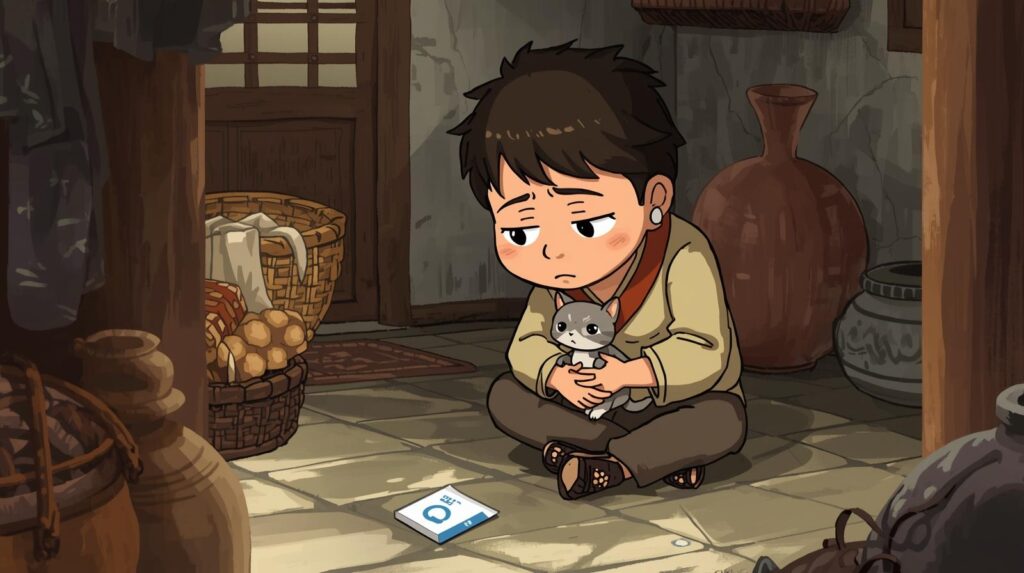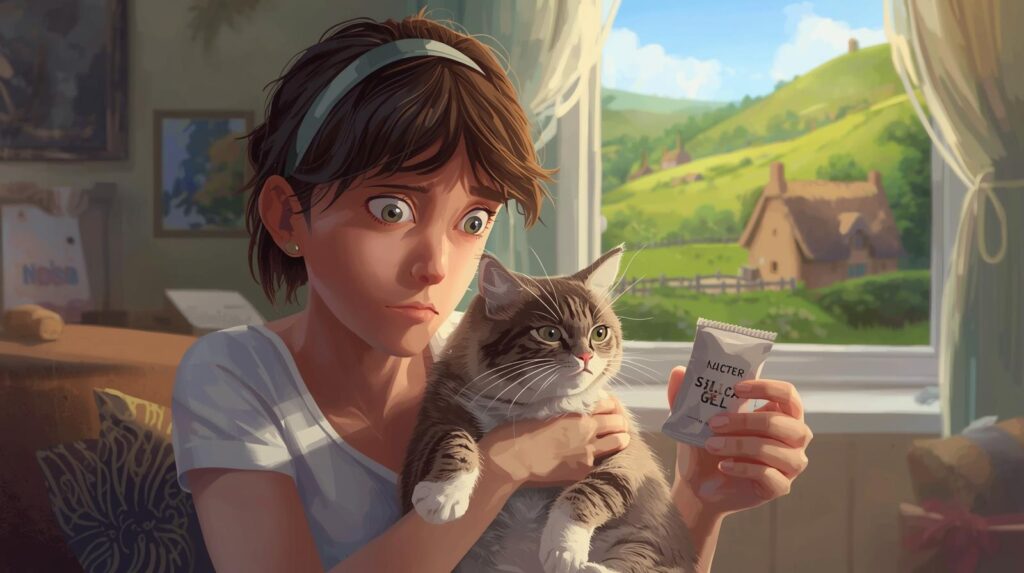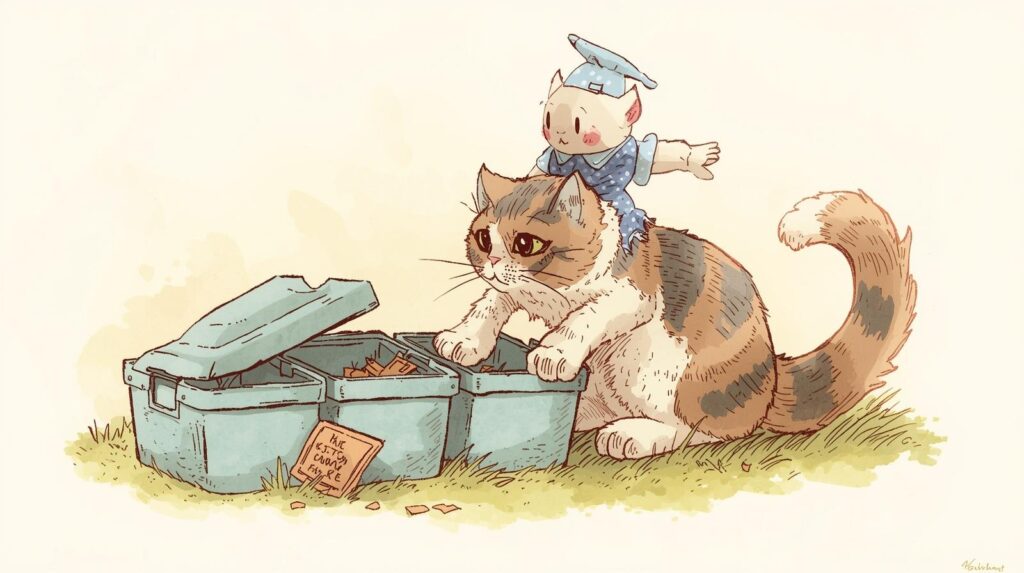
If you’re reading this, chances are you’ve recently found your cat chewing, licking, or even swallowing a silica packet from a shoebox, food container, or product packaging. And the first thought alarming your mind was:
Are silica packets toxic to cats? Good news: Silica packets are not chemically toxic to cats.
Bad news: They can still be dangerous — causing choking, intestinal blockages, vomiting, diarrhoea, and in some cases irritation from colored indicator beads like blue (cobalt chloride) or pink-dyed beads.
I write with love and care, keeping your furry friend’s health first and following the doctor’s guidance. If it helps, share it—because health and knowledge grow stronger when we share them within our community. My words are carved in stone — I truly worship my cat. Everything I share with you here comes straight from my cat’s own wisdom. That’s why I encourage you to share this blog as much as possible! Also, let me tell you — this is a top-quality blog, so make sure to read it completely to get the most benefit and keep your cats happy and healthy. A cat is the light that brightens every home.
Table of Contents
What Happens If a Cat Eats a Silica Packet?

When you realise your cat has chewed or swallowed a silica packet, it can feel scary — but take a breath. In most cases, silica gel itself is not chemically toxic. The real danger comes from choking, stomach irritation, or a blockage, especially in kittens or cats that swallow the packet whole.
To understand what actually happens inside a cat’s body, here’s the simple breakdown:
1. Silica Gel Isn’t Poisonous — But It’s Not Meant to Be Eaten
Silica gel is a moisture-absorbing material found in new shoes, bags, vitamins, and packaged snacks. It doesn’t dissolve in the stomach, and it isn’t digested.
So when a cat eats it:
- The beads pass through their digestive system
- They may cause irritation
- They pull moisture from the stomach and intestines
- They can create mild swelling inside the gut
This is why some cats exhibit no symptoms at all, while others experience discomfort for several hours.
2. The Silica Packet Itself Is the Bigger Danger
The packet is made of stiff paper or plastic that doesn’t break down.
If swallowed whole, it can get stuck in:
- The throat (causing gagging or choking)
- The esophagus
- The intestines (creating a blockage)
This risk is much higher in:
- Kittens
- Senior cats
- Small-sized breeds
Because their digestive tracts are narrower and more sensitive.
3. Some Silica Packets Contain Toxic Indicator Beads
Most packets contain clear beads — totally non-toxic.
But colored packets can be a problem.
- Blue beads → may contain cobalt chloride (toxic if chewed or swallowed)
- Pink beads → dye can irritate the stomach
- Orange beads → generally safer but still not edible
If your cat ingested a colored bead, there is a higher chance of:
- Vomiting
- Drooling
- Stomach pain
- Lethargy
This is where immediate monitoring becomes important.
4. Possible Symptoms After Eating a Silica Packet
Some cats show symptoms within 30 minutes; others may take up to 12 hours.
Look for:
- Vomiting or repeated retching
- Drooling more than usual
- Refusing food
- Diarrhea
- Acting restless or unusually quiet
- Swollen or tender belly
- Straining to poop
- Hiding or avoiding contact
Even one of these symptoms is a sign that the silica is causing discomfort inside the digestive tract.
5. In Many Cases, It Passes Naturally
If the cat only ate a few beads, and not the packet itself, the beads will often pass through the stool within 24–48 hours.
You may notice:
- Tiny clear pellets in the litter box
- A slightly softer stool
- A temporary decrease in appetite
This is normal — simply monitor your cat’s condition and keep them hydrated.
6. When It Becomes an Emergency
Seek veterinary help immediately if your cat shows:
- Continuous vomiting
- A swollen or painful abdomen
- Zero poop for 24–36 hours
- Trouble breathing (choking risk!)
- Blue, pink, or orange bead ingestion
- Lethargy or collapse
These symptoms may indicate a blockage or toxic reaction from indicator beads.
7. Why Cats Eat Silica Packets in the First Place
Believe it or not, cats find the crinkly sound and paper texture interesting.
Curiosity makes them:
- Bat the packet around
- Bite into it
- Taste the beads
- Sometimes swallow them accidentally
They aren’t trying to eat it — they are simply exploring.
The Good News
In most cases, cats who eat silica packets recover completely, especially with quick action and monitoring. Understanding how silica behaves in the body gives you the power to respond calmly and correctly.
What to Do Immediately If Your Cat Chews or Swallows a Silica Packet
If you just discovered your cat chewing, licking, or swallowing a silica packet, don’t panic. Most cats recover without complications — but the steps you take in the first few minutes matter. Here’s a clear, calm, vet-informed guide to help you handle the situation safely and confidently.
1. Stay Calm and Remove the Remaining Packet
Cats react to your energy. If you panic, they panic.
Gently but quickly:
- Remove the packet or leftover pieces
- Keep it where you can see the colour of the beads
- Avoid letting your cat play with or chew the packet again
This helps you identify what type of silica your cat ingested.
2. Check the Colour of the Beads
This is extremely important.
- Clear beads → non-toxic, lowest danger
- Orange beads → non-toxic but can irritate
- Pink beads → may contain dye, mild stomach irritation
- Blue beads → may contain cobalt chloride, which can be toxic if swallowed
3. Gently Inspect Your Cat’s Mouth

Look inside your cat’s mouth only if your cat cooperates — don’t force it.
Check for:
- Loose beads stuck inside
- Packet paper or plastic pieces
- Excessive drooling
- Bleeding or signs of irritation
If you see remaining beads, you can carefully sweep them out using your finger or a damp cloth.
4. Offer Fresh Water Right Away
Silica absorbs moisture — including moisture inside your cat’s stomach.
Water helps reduce:
- Dryness
- Irritation
- Dehydration risk
Place fresh water near your cat and encourage them to drink naturally (never force water).
5. Do NOT Make Your Cat Vomit
While this might work for other toxins, it is dangerous here.
Inducing vomiting can cause:
- The packet gets stuck in the throat
- Beads to enter the airway
- Choking risk
- Aspiration (fluid entering lungs)
Let the body handle it naturally unless a vet instructs otherwise.
6. Monitor Your Cat Closely for 24–48 Hours
This is the period when symptoms may appear.
Watch for:
- Vomiting
- Drooling
- Refusing food
- Diarrhea
- Swollen stomach
- Lethargy
- Straining in the litter box
- Constant hiding or discomfort
Write down any symptoms — this helps your vet evaluate the situation faster.
7. Call Your Vet Immediately If…
Contact a vet right away if:
- The silica beads were blue or pink
- Your cat swallowed the entire packet
- Your cat is a kitten, a senior, or a very small breed
- Your cat has health conditions like asthma or digestive issues
- You see nonstop vomiting or severe diarrhoea
- Your cat is breathing strangely or choking
Vets may advise:
- At-home monitoring
- An emergency visit
- X-rays if blockage is suspected
- IV fluids
- Medication for pain or nausea
Getting help early prevents complications.
How to Know If Your Cat Is Having a Reaction to Silica Packets
Even though silica gel itself is generally non-toxic, some cats can still experience discomfort, irritation, or digestive upset after chewing or swallowing a packet. Knowing the signs early helps you act fast, stay calm, and protect your cat from complications.
The good news? Most reactions are mild, and understanding the symptoms helps you stay one step ahead.
1. Watch Your Cat Closely for the First 2–6 Hours
This is usually the time when symptoms appear.
Even if your cat looks normal, keep an eye on:
- Their breathing
- Appetite
- Litter box behaviour
- Mood and activity level
Many reactions are subtle at first.
2. Common Mild Symptoms You May Notice
These symptoms are typically caused by:
- Stomach irritation
- The beads absorbing moisture
- Packet material scraping the digestive tract
Your cat may show:
- Mild vomiting or retching
- Drooling more than usual
- Small decrease in appetite
- Soft stool or mild diarrhoea
- More frequent swallowing or lip licking
- Curiosity turning into restlessness
Most mild symptoms improve within a few hours.
3. Signs of Irritation From Colored Beads
If your cat ingested blue, pink, or indicator beads, the reaction may be stronger.
Watch for:
- Bright pink vomit (from dye)
- Blue-tinted saliva or stool
- Coughing or gagging
- Visible discomfort when touched on the belly
These symptoms mean the dye or chemical indicator may be irritating your cat’s stomach lining.
4. Signs of a Possible Intestinal Blockage (More Serious)
This is rare but important.
A blockage can happen if your cat swallows:
- The entire packet
- A large piece of packet paper
- A clump of beads
Symptoms may include:
- Repeated vomiting
- Hard, swollen belly
- Straining without producing stool
- No poop for 24–36 hours
- Hunching, hiding, or crying when touched
- Refusing food completely
A blockage is an emergency — cats can deteriorate quickly if untreated.
5. Respiratory Symptoms (If Your Cat Choked or Inhaled Beads)
If a bead went toward the airway, you may notice:
- Wheezing
- Coughing fits
- Fast or heavy breathing
- Pawing at the mouth
- Sudden panic or agitation
This requires immediate veterinary attention.
6. Emotional or Behavioural Changes to Pay Attention To
Cats often communicate discomfort through behaviour.
Look for:
- Unusual hiding
- Less grooming or too much grooming
- Sudden clinginess
- Refusal to play
- Stiff body language
Cats hide pain instinctively — small behaviour changes can tell you a lot.
7. How Long Symptoms Usually Last
If your cat has a mild reaction, symptoms often last:
- 2–12 hours for stomach upset
- 12–24 hours for mild irritation
- 24–48 hours for colored bead ingestion
- Up to 3 days if the packet caused constipation
If symptoms don’t improve — or get worse — call your vet.
8. When You Should Contact a Veterinarian
Reach out to your vet immediately if you see:
- Persistent vomiting
- Blood in stool or vomit
- A swollen or painful belly
- Difficulty breathing
- Refusal to eat for more than 12 hours
- A kitten swallowing the packet
- Colored (blue/pink) beads ingested
- Zero poop in 24–36 hours
Early treatment prevents complications and helps your cat recover faster.
Are Silica Packets Toxic to Cats If They Break Open?
When a silica packet breaks open, it immediately looks scary — tiny beads scattered everywhere, your cat sniffing around, and your mind jumping to the worst-case scenario. But here’s the part most pet parents don’t know: a broken silica packet isn’t automatically toxic… but it can be dangerous in other ways.
Let’s break this down in the clearest, most comforting way possible.
1. The Beads Themselves Aren’t Poisonous — But They Still Cause Problems
Most silica packets contain clear or white beads.
These are:
- Chemically inert
- Non-toxic
- Non-digestible
But when exposed, they can:
- Dry out your cat’s mouth or stomach
- Causes temporary irritation
- Looks like tiny toys your cat wants to bat or eat
- Stick to fur or paws
So, not poisonous…
…but definitely not safe to leave around.
2. The Real Risk = How MUCH Your Cat Ate
In 2025, vets often explain silica ingestion using the “3-Risk Rule”:
Low Risk:
The cat licked or sniffed the beads
→ Usually no symptoms
Moderate Risk:
The cat chewed or ate a few beads
→ Mild vomiting, drooling, or soft stool possible
High Risk:
Cat swallowed a large number of beads
→ Dehydration or stomach irritation
Critical Risk:
Cat swallowed packet pieces + beads
→ Possible intestinal blockage (especially in kittens)
This method helps pet owners understand severity without panic.
3. If the Beads Are BLUE or PINK — This Changes EVERYTHING
Modern silica packets sometimes use indicator beads that change color with moisture.
Here’s the part most competitor blogs never mention:
- Blue silica = may contain cobalt chloride → potentially toxic if eaten
- Pink silica = dye-coated silica → can irritate the stomach
Your reaction should be FAST if you see these:
Blue beads? → Call vet immediately
Pink beads? → Monitor closely + offer water
This is where broken packets go from “annoying” to “urgent.”
4. A Broken Packet Can Spread Beads Everywhere
When a packet bursts open, the beads scatter like glitter — tiny, round, and impossible to see all at once.
Cats may:
- Step on them
- Lick paws
- Inhale dust
- Roll in them
- Eat them while grooming
Even if the amount eaten is small, accidental ingestion becomes more likely.
5. Silica Dust Is a Hidden Irritant
Some older packets release a small amount of dust when torn.
Cats might experience:
- Sneezing
- Eye watering
- “Reverse sneezing”
- Coughing
- A scratchy throat
It’s not toxic, but it can feel uncomfortable, like us inhaling powder.
Can Silica Packets Cause Intestinal Blockages in Cats?
When a cat swallows a silica packet, most owners worry about toxicity — but the real danger is often something much simpler and far more physical: intestinal blockage. And yes, even though silica gel isn’t poisonous, the packet itself can become a mechanical obstacle inside your cat’s digestive tract.
This section breaks down the risk in the clearest, most modern 2025-friendly way.
1. The Silica Beads Rarely Cause Blockage — But the Packet Can
The beads are tiny, smooth, and usually pass through the digestive system without drama.
The real threat is:
- The paper or plastic packet
- A clump of beads eaten together
- Packet corners that don’t break down
- Moisture-packed beads sticking together
Think of the packet as a “mini sponge.”
Once swallowed, it expands slightly — and that’s when problems can begin.
2. The Cats at Highest Risk of Blockage
Not all cats face the same danger. Some are far more vulnerable.
High-risk cats include:
- Kittens (tiny intestines + habit of chewing everything)
- Senior cats (weaker digestion)
- Small breeds like Singapura or Munchkin
- Cats with digestive disorders
- Cats who eat fast or panic-chew
- Cats who swallow objects whole
If your cat falls into any of these groups, take packet ingestion more seriously.
3. The “Blockage Timeline” Vets Use
Blockages don’t happen instantly — they develop.
Here’s the general timeline vets follow:
0–6 hours:
The cat may seem normal or show mild vomiting.
6–12 hours:
Stomach becomes irritated → repeated vomiting begins.
12–24 hours:
Food stops passing through → cat stops eating.
24–36 hours:
No stool, belly swelling, or painful abdomen.
36+ hours:
Dehydration, lethargy, and possible emergency surgery are required.
Understanding this timeline helps owners spot problems before they get severe.
4. The Early Warning Signs of a Blockage
A blockage often starts with small, almost “easy-to-ignore” symptoms.
Watch for:
- Repeated vomiting (especially after eating or drinking)
- Constant swallowing or lip licking
- Refusing food
- Drooling
- Hiding or acting unusually still
- Small, dry stool
These are signals that food isn’t moving properly.
5. More Serious Symptoms That Need Urgent Vet Care
These are the “red alert” symptoms:
- A hard, swollen, or round belly
- Zero poop for 24–36 hours
- Crying when touched near the stomach
- Extreme lethargy
- Repeated vomiting with nothing coming out
- Collapsed posture or dehydration
This stage can become life-threatening — especially for kittens.
Are Colored Silica Packet Beads Toxic to Cats? (Blue, Pink, Orange)
Colored silica beads look harmless, but in 2025, pet-safety guidelines, not treat all colours equally. Some are safe, some are mildly irritating… and one specific colour can actually be toxic for cats. Here’s the simplified but expert-backed breakdown every cat parent must understand.
Which Colored Silica Beads Are Safe — and Which Are Dangerous?
Not all silica packet beads are made the same. The colour tells you exactly what’s inside.
1. Blue Silica Beads — Potentially Toxic
Blue beads often contain cobalt chloride, a moisture-indicator chemical.
This is the only type linked to toxic reactions in pets when chewed or swallowed.
Possible effects include:
- Mouth irritation
- Vomiting
- Excessive drooling
- Stomach upset
- Rare: toxicity from cobalt exposure
Risk Level: High — Avoid completely
2. Pink Silica Beads — Irritating but Less Dangerous
Pink beads usually turn blue when moist and contain indicator dye, not cobalt.
Not toxic, but it can still irritate your cat’s stomach and mouth.
You may see:
- Mild vomiting
- Temporarily reduced appetite
- Pink dye in drool or vomit (non-toxic but alarming)
Risk Level: Moderate — Keep away from cats
3. Orange Silica Beads — Considered Safe
Most orange beads use iron salt instead of cobalt. These are the newer, safer moisture-indicator styles popular in 2024–2025.
Typical issues if swallowed:
- Mild dry-mouth
- Temporary thirst
- Possible constipation if large amounts are consumed
Risk Level: Low — But still avoid ingestion
How Much Is Dangerous for Cats?
Severity depends on 3 things:
- Quantity eaten
- Type and colour of beads
- Cat’s size and age
A single bead rarely causes serious harm —
But a mouthful of blue silica beads is an emergency.
Signs Your Cat Is Reacting to Colored Silica Beads
Watch for these symptoms over the next 2–24 hours:
- Drooling or pawing at the mouth
- Repeated vomiting
- Lethargy or hiding
- Refusing food
- Bright-blue dye around the mouth (blue beads)
- Constipation or straining
Vet-Approved Recommended Products for you
1. Micro-Pak Dri Clay Desiccant
- This is a clay-based desiccant (not silica-gel), which many consider safer because it’s inert and non-toxic.
- Vets like inert options because even if ingested, clay is less likely to cause swelling or chemical irritation.
- Use these in places where you already use moisture absorbers — but still keep them out of your cat’s reach.
2. Bamboo Charcoal Dehumidifier Bags
- While not exactly “packet desiccants,” these are natural moisture absorbers.
- These bags are a good alternative: no hard silica beads, just charcoal that traps moisture.
- Many pet-safety advocates recommend charcoal bags over silica in high-risk cat households because of lower ingestion risk.
3. Silica Gel With Non-Toxic Indicator
- If you must use silica gel, choose packets that use safe indicator beads (not cobalt chloride).
- Avoid blue-indicator beads — as vets warn, those may be more toxic.
- Use these only in sealed containers that your cat cannot open.
Further Readings: You may need
Why Is My Cat Peeing Outside the Litter Box?
How to pick a puppy from a litter
FAQs- Are Silica Packets Toxic to Cats
What makes silica packets potentially dangerous to cats?
Silica packets are considered low-toxicity, but they can still be dangerous to cats because the silica gel beads inside can cause choking, stomach irritation, or even an intestinal blockage if swallowed.
Some packets also use blue indicator beads containing cobalt chloride, which may be harmful if a cat ingests large amounts.
Why are silica packets labelled “Do Not Eat,” and what does that mean for cats?
The warning is meant for humans, but it applies to pets too.
Silica packets contain moisture-absorbing beads that are not poisonous but can cause digestive stress or a foreign body obstruction in cats.
This warning also includes concerns over colored indicator silica, which is riskier.
What should I do if my cat eats a silica packet?
Immediately remove any remaining desiccant packet pieces, keep the packet for identification, and observe your cat.
If you see symptoms like vomiting, drooling, diarrhoea, or lethargy, call your vet.
These signs may indicate silica gel irritation or a possible blockage.
How do I know if silica packets are toxic to cats?
Silica packets are considered non-toxic, but some varieties become risky when they contain colored indicator beads with chemicals.
To know if the packet is toxic, check if the beads are blue or pink, which usually means a chemical indicator is present.
Why do cats try to chew silica packets?
Cats are naturally curious and may be attracted to the crinkling sound, the plastic texture, or the smell from food packages.
Some cats also chew non-food objects, a behaviour linked to pica, stress, or boredom.
What symptoms appear after a cat swallows silica gel?
Symptoms may include:
Vomiting
Drooling
Refusal to eat
Constipation or diarrhoea
Lethargy
These are typical cat poisoning symptoms, especially if the packet contained colored silica gel.
When should I take my cat to the vet after eating silica packets?
You should take your cat to the vet immediately if they swallowed:
The entire packet
Blue or pink indicator beads
A large amount of crystalline silica
Or if symptoms appear within 2–6 hours.
Cats that develop abdominal pain or repeated vomiting need urgent attention.
How dangerous are silica packets for kittens?
Kittens are at higher risk because they are smaller, more curious, and more likely to swallow objects whole.
Even small moisture-absorbing beads can cause choking or a bowel blockage in kittens.
Wrap up
Silica packets may look tiny and harmless, but for curious cats, they can turn into a real safety concern. While most silica gel packets are technically non-toxic, the real danger lies in the choking risk, stomach irritation, possible intestinal blockage, and the presence of colored indicator beads that may contain chemicals.
What matters most is your quick action and awareness. If your cat eats, chews, or even licks a silica packet, always check the packet type, look for blue or pink beads, and monitor your cat closely for the next 24–48 hours. And when in doubt, calling your vet is always the safest choice — even minor symptoms can escalate quickly in pets.
The safest approach is prevention:
- Keep packets out of reach,
- Switch to pet-safe alternatives,
- Use secure storage containers, and
- Stay aware of what comes inside your packages.
As pet parents, we can’t stop our cats from exploring the world — but we can make that world safer. With the right knowledge, calm action, and a bit of smart prevention, you can protect your furry friend from unnecessary risks and keep them healthy, happy, and curious in all the right ways.
I write with love and care, keeping your furry friend’s health first and following the doctor’s guidance. If it helps, share it—because health and knowledge grow stronger when we share them within our community. My words are carved in stone — I truly worship my cat. Everything I share with you here comes straight from my cat’s own wisdom. That’s why I encourage you to share this blog as much as possible! Also, let me tell you — this is a top-quality blog, so make sure to read it completely to get the most benefit and keep your cats happy and healthy. A cat is the light that brightens every home.


